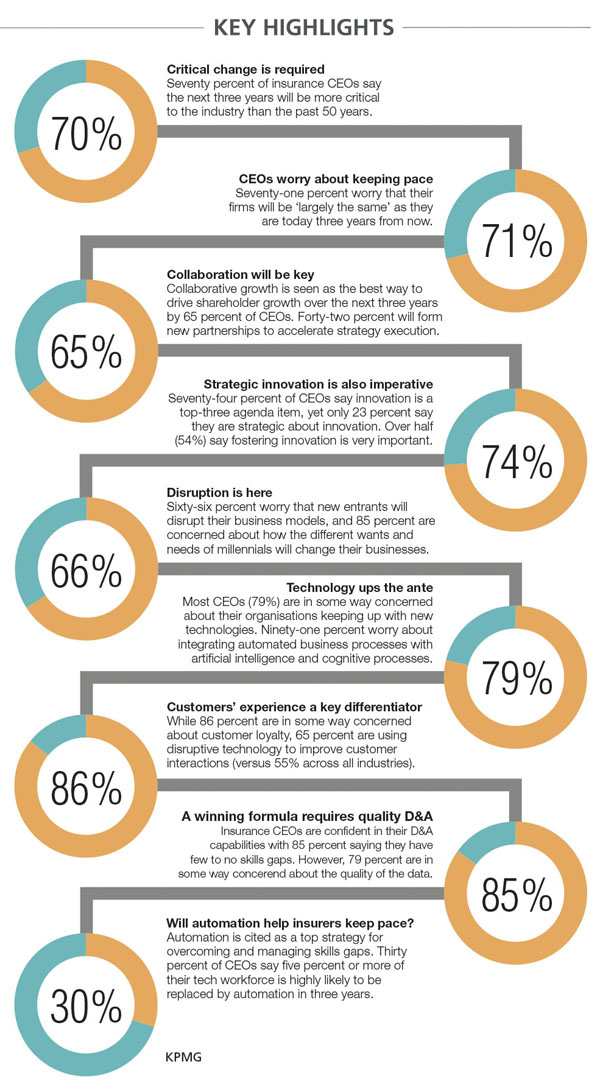GLOBAL SURVEY
INSURANCE CEO OUTLOOK
Courtesy KPMG Sri Lanka
INSURANCE CEOs SPEAK THEIR MIND
Challenges and opportunities emerge from a 2016 global insurance CEOs’ outlook survey
Insurance executives recognise that the low-interest-rate environment is not going away any time soon. They feel the pace of competition heating up. The big question on everyone’s mind is how to achieve profitable growth in today’s insurance market.
To help answer this question, KPMG surveyed more than 100 insurance CEOs at the beginning of last year. They were asked about their growth expectations, challenges, investments and capabilities. This exercise also covered key topics such as technology, regulation and competition.
 STRATEGIC LENS Insurance CEOs are becoming much more strategic about their inorganic investments. Almost half (45%) say they expect to pursue a merger with another firm in the next three years.
STRATEGIC LENS Insurance CEOs are becoming much more strategic about their inorganic investments. Almost half (45%) say they expect to pursue a merger with another firm in the next three years.
Every insurer is seeking the ‘next’ big growth opportunity. And in today’s slow-economic-growth and low-interest-rate environment, it is clear that inorganic growth – through mergers, acquisitions, partnerships and alliance transactions – will continue to be a critical component of any insurer’s long-term growth strategy.
The fact that insurance CEOs are beginning to refocus their mergers and acquisitions (M&A) initiatives through a more strategic lens is good news for the sector, and for stakeholders and investors. But this is only the beginning of a much more focussed shift towards strategy-driven transactions within the insurance sector that will ultimately define the competitive landscape in the future.
Clearly, doing nothing at all is not a strategy for long-term success. Indeed, in today’s fast-paced and highly competitive marketplace, change is not only about winning new customers; it’s about survival too.
WINNING FORMULA Unfortunately, there is no universal road map to success – no ‘off-the-shelf’ solutions or proven methodologies. Rather, experience suggests that each organisation will need to focus on balancing the right combination of actions, strategies and investments to create a unique winning formula for their particular organisation.
Despite the challenges, forward-looking insurers are setting the pace for the sector through collaboration, disruptive technology, automation, and their use of data and analytics.
CRITICAL FINDINGS Here are some of the key findings from the KPMG 2016 global insurance CEO outlook survey of more than 100 of the largest players in the sector.
Firstly, while CEOs state that they are still grappling with growth in what seems like an interminably low-interest-rate environment, there are many bright spots.
 Insurance CEOs are proactively seeking collaborative opportunities to enhance shareholder value. And they are much more likely than CEOs overall to be adopting disruptive technology to improve customer interactions. It’s no wonder that over 70 percent of this innovation is a leading agenda item.
Insurance CEOs are proactively seeking collaborative opportunities to enhance shareholder value. And they are much more likely than CEOs overall to be adopting disruptive technology to improve customer interactions. It’s no wonder that over 70 percent of this innovation is a leading agenda item.
They also say that cyber risk remains a major concern along with disruptions to their business models through new entrants and technology, and millennials.
But the challenge is managing change in a holistic and integrated manner.
On the one hand, insurers will need to think about their business models and where they want to play in the future. At the same time, they will also be required to focus clearly on their operating models to sharpen their competitive advantage in current and future markets. They will need to make the best use of their internal resources while also working with external partners to fill gaps and drive speed to market.
Similarly, people and technology will need to be balanced. Executives will want to address the ‘two-speed’ dilemma: high-speed front-end omni-channel implementations/innovations while rationalising legacy systems and introducing new technology usually at a slower speed at the back end of the value chain.
They may need to change their culture to attract new talent – e.g. data analytics, innovation and partnering – and encourage new ideas. But they will also need to balance this with the need to maintain their legacy and closed books of business, and an overarching focus on risk.



